May 15th, 2015
3D Vision – Lark Life
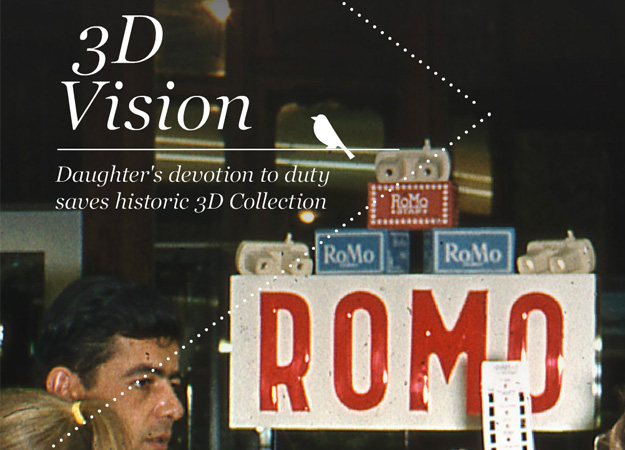
Lark Life, a UK award Winning Insurance Broker, published in its magazine circulated to its private clients an article on ‘3D Vision – Daughter’s devotion to duty saves historic 3D Collection’.
April 1st, 2014
Buzz Hayes
Through a mutual friend in Los Angeles, Betty Thayer was introduced to the 3D team at Sony Pictures and visited with Mr Bob Bailey (Senior Vice President) and Mr Buzz Hays (Director of 3D) in 2013. After numerous conversations Elizabeth Mouzillat Jowett was invited by Buzz Hays to an invitation-only 3D Summit at the British Film Institute in London, at which he was speaking at.
We were pleased to discover after supplying a number of sample images of the Collection, that Buzz based a large amount of time in his talk about RoMo and urged that the audience should take the opportunity to attend the exhibition at the Holburne Museum in Bath.
Mr Hays now runs his own company, is the founding Chairman of the International 3D Society, Lead Instructor of the UT3D program at University of Texas at Austin, Texas and Senior Lecturer at the Moody College of Communication.
March 14th, 2014
‘Artists in 3D’ by David G Burder
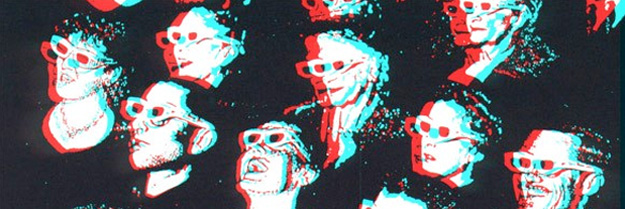
On 11 March 2014 a talk was given during the Exhibition by David G Burder, introduced by Dr. Michael Pritchard (Director General of the Royal Photographic Society), entitled ‘Artists in 3D’ where the RoMo Collection featured prominently as part of the talk.
February 8th, 2014
The camera trick that brings Picasso back to life – Daily Mail Online
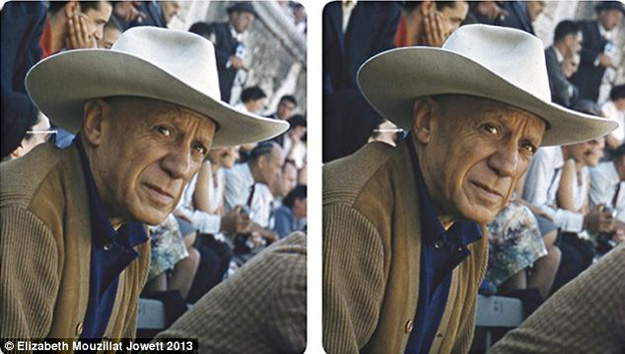
At about the same time the Daily Mail newspaper published an article entitled ‘Picasso Brought Back to Life: 3D Photos of Legendary Artist’ about the exhibition at the Holburne Museum and also referenced the Collection.
September 10th, 2013
Sir John Richardson
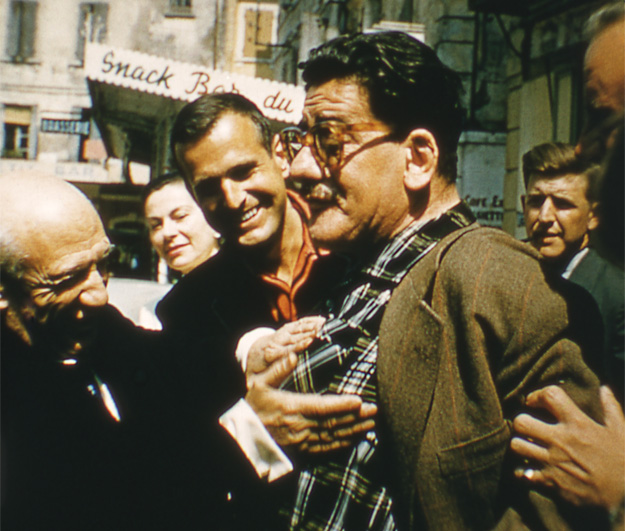
In the 1980s the world-renowned Art Historian, Sir John Richardson was introduced to Robert Mouzillat by the then Chairman of Sotheby’s New York. He proposed to Sir John Richardson to visit Robert Mouzillat at his home in Paris because Sir John Richardson was preparing the next volume of the authorised biography of Picasso. At that meeting Richardson saw the 3D images for the first time, of himself with Picasso together with the filmmaker Jean Cocteau and other well known personalities of the period.
Elizabeth Mouzillat Jowett, through her father, was in communication with Sir John Richardson over the intervening years. On a visit to New York in September 2011 John Richardson invited Elizabeth Mouzillat Jowett and Betty Thayer to tea at his home to talk about mutual experiences of living in Provence in the 1950s, the RoMo Image Library and particularly the Picasso images.
John Richardson was delighted to accept a copy of the photograph of himself with Picasso and the surrealist painter Oscar Dominguez and most kindly offered to help RoMo in any way he could. This resulted in Sir John Richardson writing The Forward to the Exhibition Catalogue ‘Stereoscopic Photographs of Picasso’ held at The Holburne Museum, Bath.
One of the exhibited images shows Sir John Richardson together with Robert Mouzillat and Jean Cocteau and other close friends of Picasso.
July 23rd, 2013
Dr Brian May
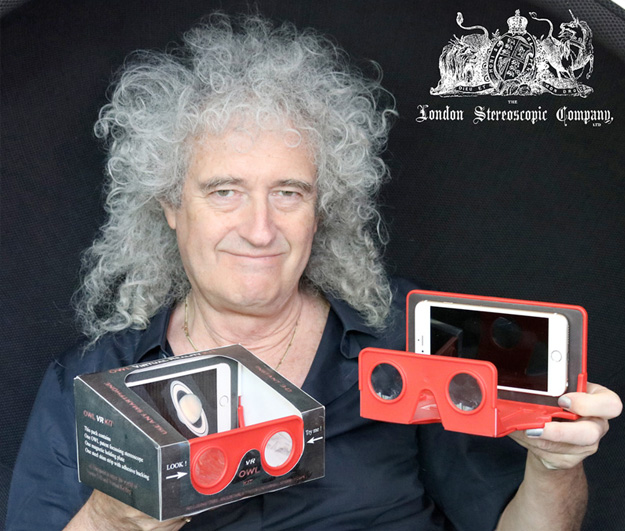
We were kindly assisted in the preparation of images for this exhibition by the invaluable participation of Dr. Brian May, proprietor of The London Stereoscopic Company, and his colleague Denis Pellerin.
We were introduced to Dr Brian May by mutual friends in 2011 and corresponded as to the future of the Image Library. We were later invited by The Holburne Museum, Bath to exhibit ‘Stereoscopic Photographs of Picasso’ and the images were selected by Dr Alexander Sturgis.
During this time a contact of Dr Sturgis mentioned that he published Brian May’s books and suggested Dr May may be interested in the project, due to his lifelong interest in vintage stereoscopic images. We were delighted and appreciative that Dr May volunteered to participate and spent many hours in the preparation of the images so they could be viewed in 3D on screens at the exhibition, and in the catalogue through The London Stereoscopic Company’s Owl viewer.
March 1st, 2013
Stereoscopic Photographs of Pablo Picasso – Exhibition
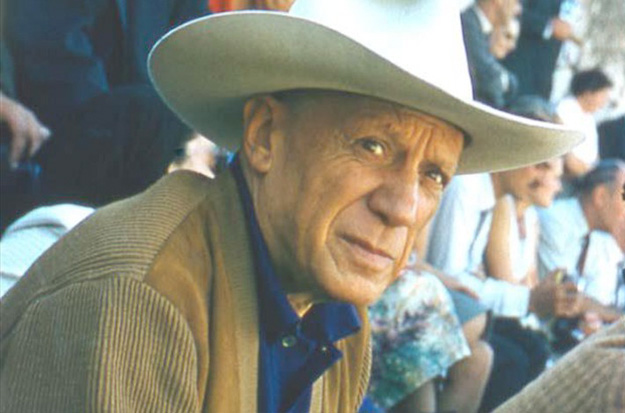
In 2013 the Director of The Holburne Museum, Bath, Dr Alexander Sturgis (appointed Director, University of Oxford’s Ashmolean Museum, October 2014) was approached by Mrs Thayer, a patron of the Museum, to explore the possibility of holding an exhibition at the Museum of a part of the collection of Picasso images showing them on modern 3D screens and viewed with passive 3D glasses.
Dr Sturgis visited Jersey to view the 200 images that were taken in 1957 and made his selection, which included Picasso in his studio and garden of his home La Californie, the Easter bullfight and celebrations amongst his friends in Arles. This group of friends included Sir John Richardson (art historian and official biographer of Picasso), Jaime Sabartès, Jean Cocteau and surrealist artist, Oscar Dominguez. It was the weekend of one of the great bullfights or corridas in Arles, which were among the few events that lured Picasso from the grounds of his home La Californie. In contrast to almost all other photographs of Picasso taken at this time, they are in colour and even more remarkably they are in 3D. These images that would be shown at the exhibition have not been exhibited or seen outside of the Collection before.
In addition to the exhibition a booklet was prepared that features many of the photos included in the exhibition. Dr Brian May was instrumental in preparing the images and providing the appropriate viewer for the booklet.
September 7th, 2012
Tintin & Hergé
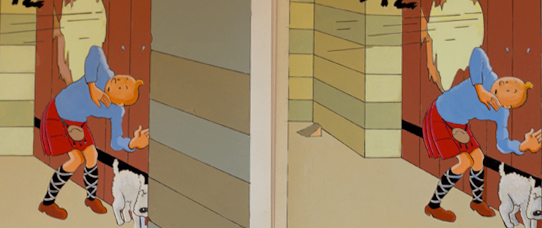
With the production of the stereocards of “Les Aventures de Tintin” it is believed that RoMo was the first company to produce Tintin bandes dessinées in combined colour and stereoscopic format.
In 1957 RoMo contacted Casterman, the publishers of Hergé’s Tintin, to discuss implementation of a series of stereocards, the subject being “Les Aventures de Tintin”. The two companies came to a rapid agreement: RoMo would produce and distribute the stereocards of a Tintin adventure as a set of 12 stereoscopic drawings, using the RoMo stereocard format.
At the start, RoMo would produce a series based on “Tintin in the Congo”, the second of Hergé’s Tintin series. The projects had to be approved with the agreement of Hergé, as did the choice of the various selected images to be used.
In May 1957 RoMo received at its Paris office a file of 4 pages of proposals for 25 stereocards to be developed between RoMo and Hergé’s team. All the images produced were to be approved by Hergé and the choice of the images were to be made by Studio Hergé.
The first set of stereocards were:
- “Tintin, Milou et le crocodile” (from “Tintin au Congo”)
- “Tintin, Milou et le serpent” (from “Tintin au Congo”)
- “Tintin au poteau de torture” (from “Tintin en Amerique”)
- “Tintin et la locomotive” (from “Tintin en Amerique”)
- “Tintin et les policiers” (from “Les Cigares du Pharaon”)
- “Tintin et les bedouins” (from “Les Cigares du Pharaon”)
- “Tintin et le fakir” (from “Le Lotus Bleu”)
The above series were to be the only stereocards cards created.
The artist working with RoMo encountered several problems with the frames proposed and Hergé himself didn’t find the examples proposed particularly convincing. The drawings weren’t done by Hergé himself but his team used the scenes from the books to serve as inspiration for these stereo images. Colour was added to create the 3D effect because the RoMo camera looked through the line drawings, which is believed to to be first time Hergé’s work was coloured for commercial purposes. These drawings weren’t to Hergé’s taste as they weren’t in ‘la ligne claire‘ for which his work is known.
At Christmas time 1957, after many reworking of the images to get the 3D effect working without losing the clarity of Hergé’s artwork, 3 of the images from this series were finished and made available for public purchase, and the other four series were produced and sold in Autumn 1958.
A further 5 Tintin series that the Studio Hergé wished RoMo to make were never realised.
It is estimated that the collaboration between RoMo and Casterman ended in 1960.
The Collection currently holds 202 gouache artworks of the ‘left and right eye’ images that were drawn and painted to be used to create the stereoscopic images, as well as 176 original master positive film images that were used to create the stereocards.
July 19th, 2012
University of Bristol

We were advised that the images should be digitised. That it was preferable to do so in-house rather than instructing an outside company. A great personal friend of Elizabeth Mouzillat Jowett is Professor Dr. Michael Forsyth (Director of Studies, Department of Architecture & Civil Engineering at University of Bath) suggested and put us in touch with the Professor Stephen Gray at the Institute for Learning and Research Technology, University of Bristol, the foremost centre of digitisation technology in the UK.
We arranged a meeting with Professor Gray which was attended by his assistants and students. He and his students viewed the sample originals images we had brought with us on their equipment and returned to the meeting hugely enthusiastic and amazed at the clarity and quality of the images. He decided at the meeting he would work with his staff and students on the project of digitisation of the RoMo Image Library and prepare a report and advisory document that we received in August 2012.
Following the report “RoMo Stereo Pair Digitisation” by Professor Stephen Gray of the Institute for Learning and Research Technology, University of Bristol, we implemented the recommendations and setup digitisation equipment and process for in-house viewing and to aid the cataloguing work being done.
Professor Gray came to Jersey to meet with Robbie Andrews and Catherine Kirby and verify that the setup and process would maintain the quality and standards that he had advised. RoMo was now able to digitise the images in-house and thus keep control of the intellectual property.
June 19th, 2012
Romo Images & Kodak
There were negotiations in 1964 between representatives of Robert Mouzillat and the Eastman Kodak Company intended to lead to the acquisition of the patent rights to the 3D camera by the Eastman Kodak Company of Rochester, New York. Following meetings and correspondence between the parties a satisfactory outcome could not be reached.
However the matter was revived some years later. In a letter of 2 June 1992 the then Commercial Director of Kodak Pathe concluded that: “I have never seen such images that, moreover after 40 years in storage, maintain their quality of origin, definition and colours”
June 18th, 2012
The Art Newspaper

We were pleased to be approached by The Art Newspaper who were interesting in covering the Collection as an article in their publication. It was published in September 2008, on page 9, titled “Picasso in three Dimensions”.
Picasso is no longer with us, but a cache of stereoscopic photographs of him has emerged that allow one to see the old superstar in startling 3-D. The photographer was a French inventor and educator called Robert Mouzillat, who had created his own method for stereoscopic colour photos. He took thousands of pictures of nature, surgical operations, the golfer Arnold Palmer and even a few of the pope in a red sports car. In 1957, he was invited down to Picasso’s house in the south of France, La Californie, where he took dozens of photos of the artist in his studio, with his family and then mistress, Jacqueline Roque, with friends, including the dealer Louise Leiris, the art critic and collector Douglas Cooper, and the goat. There are also numerous pictures of Picasso and friends at a bullfight in Arles. Here we have (left) horseplay between Picasso with a friend (Oscar Dominguez), with, in the middle, John Richardson, subsequently to become his biographer, and (right) Picasso in his studio with his sculpture of a fawn on his shoulder. These photos now belong to Mouzillat’s daughter, Elizabeth Mouzillat Jowett, who is based in the UK and is now considering the most suitable place for them to end up. A.S.C.
June 9th, 2012
Nudes
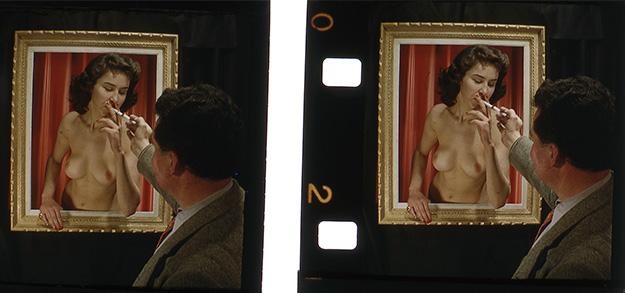
The Collection holds 260 posed photographs of nudes were taken in Paris in the 1950s. At the time, there were then strict regulations in place, for example, the Folies Bergére staged nude tableaux but none of the ladies was permitted to move. For the photographs to be taken In keeping with the law of the time, a Police licence was required and obtained by RoMo.
The former chairman of Sotheby’s, New York, the late Charlie Moffett asked Elizabeth Mouzillat Jowett at a meeting in New York whether there were any nudes in the Collection. On being told that there were a significant amount, he said that in his opinion ‘they were potentially the most important part of the Collection’.
Stereocards were sold under the following headings: Étude 1, 2 & 3; Nuit Vénitienne ; Nudist Camp, Strip Tease; Romance – Cabaret and Variations 1 – 11. Apart from the stereocards a number of the images have been printed as black and white photographs.
June 8th, 2012
Charles S Moffett
Charlie Moffett has been a very good friend of Elizabeth Mouzillat Jowett since 1970 when he was at the Metropolitan Museum of Art, New York and of her father Robert Mouzillat whom he used to visit on his frequent trips to Paris. His distinguished career continued at the National Gallery of Art, Washington DC where he was Senior Curator of Paintings in the late 1980s and early 1990s. He was appointed the first non family Director of the Phillips Collection in Washington DC from 1992 to 1998. In 1998 he joined Sotheby’s as Executive Vice-President and Vice Chairman of Impressionist, Modern and Contemporary art. He has advised on the potential exploitation of the RoMo Image Library in view of the advancing technology in stereoscopic imagery.
June 7th, 2012
Le Livre Universel
Robert Mouzillat established a company Le Livre Universel in the 1950’s. He worked with J. Arthur Rank on a joint project to create ‘’talking books’. These were hardback picture story books sold together with a vinyl record upon which the story was recorded by actors of La Comédie Francaise. Titles include ‘La Forêt Magique‘ and ‘Le Premier Matin de Noël‘.
June 6th, 2012
The RoMo Collection
After Robert’s passing, we’ve been working on understanding the content of the entire collection, currently estimated to be over 100,000 images. Fully appreciating the content and condition of the various images, image formats, other media (including some film footage) has been a priority to be able to fully understand the scale of the collection.
In 2008 Betty Thayer, a retired Ernst & Young partner and internet entrepreneur, joined the RoMo team as business advisor. She met Robert Mouzillat when he was visiting Bath in 2003 and discussed with him at length the possibilities for commercialising the collection. Her understanding of the issues associated with preparing the collection for sale, and her extensive network of relevant connections are important contributions as we move forward.
In 2010, Catherine Kirby, a professional Archivist, was brought on to catalogue the collection using archival database software ADLIB, keeping as close as possible to the original way that the creator Robert Mouzillat had organised the collection.
In 2011 we launched this website, alongside a refreshed RoMo Images brand, to allow those interested in the collection to be able to find out more information.
In 2012 we started experimenting, with the help of Robbie Andrews, who came on board as Technical Advisor, with looking at how we could utilise these images in a polarization stereoscopic format to be displayed on modern screens. Original testing was successful and has led us to continue to explore further modern means that would allow the collection could be viewed.
There have already been numerous enquiries by many interested parties about the future of the collection and we look forward to the exciting road ahead.
